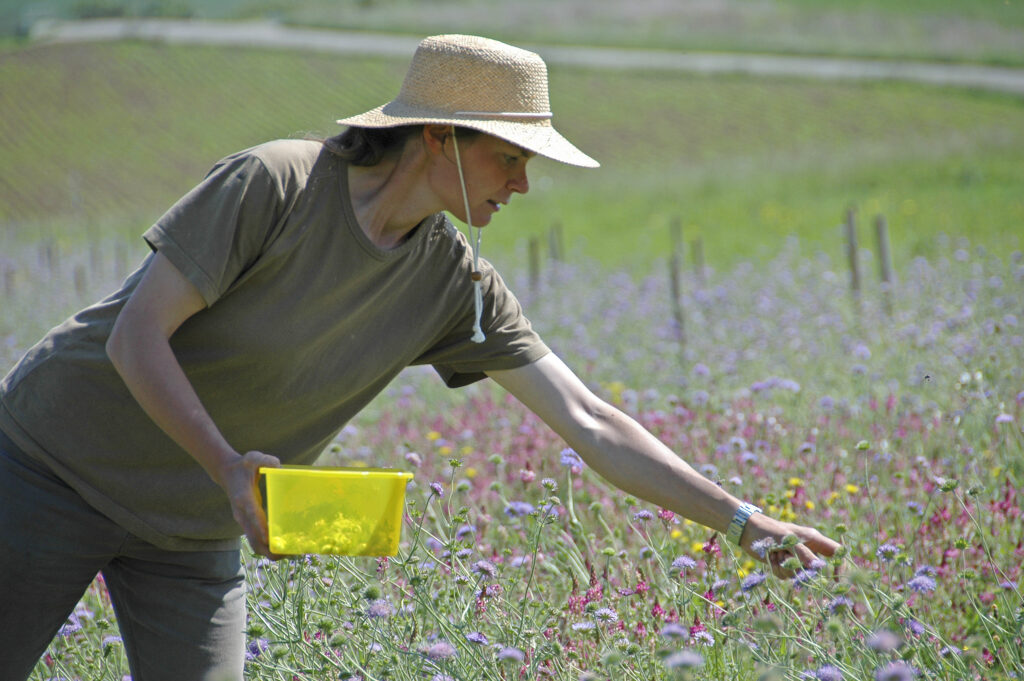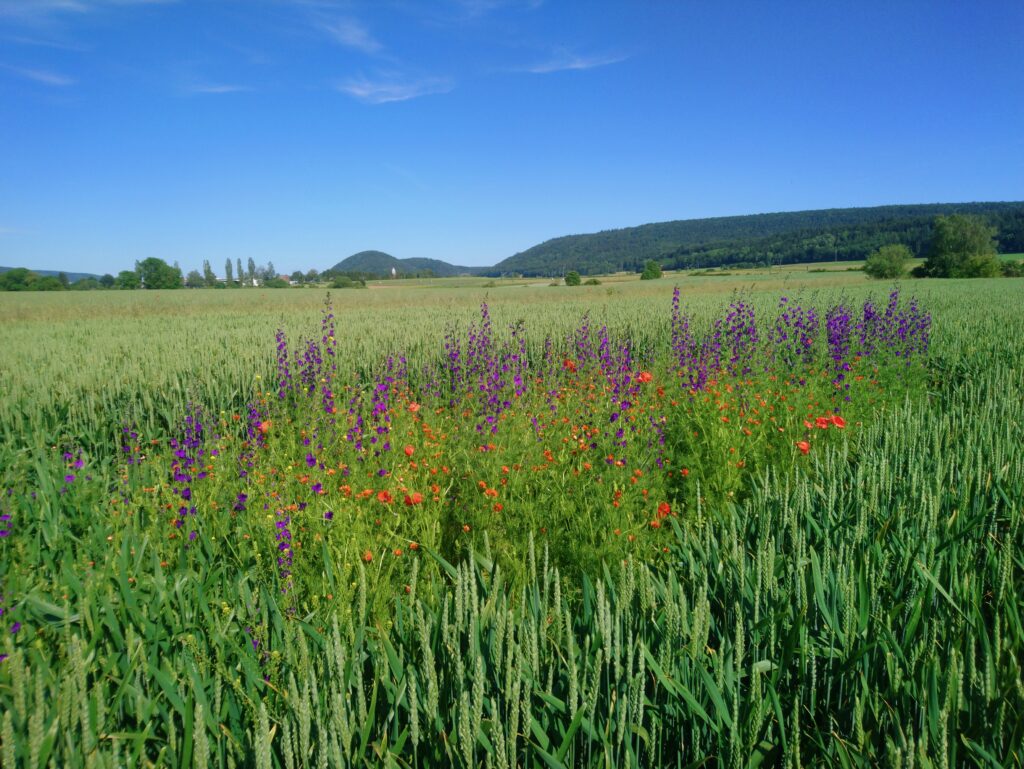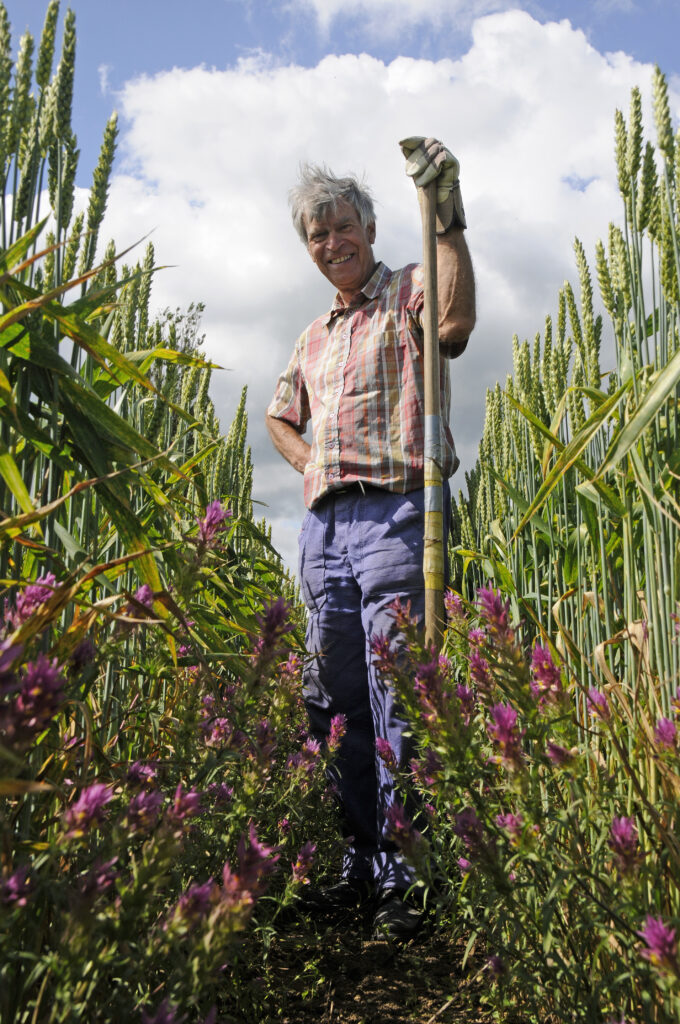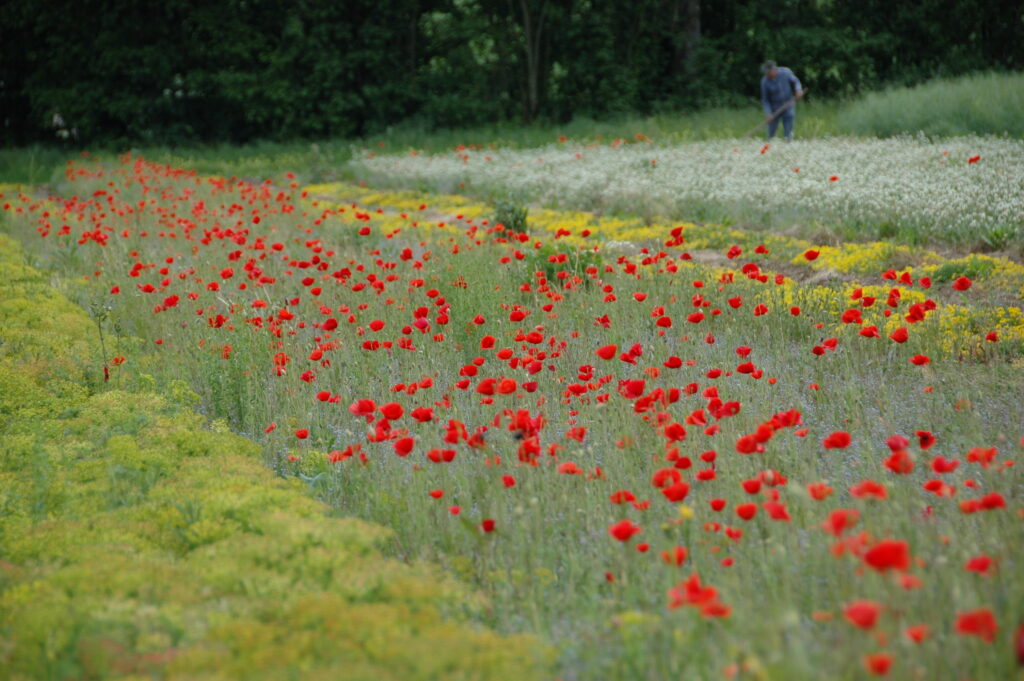How Swiss farmer Gabi Uehlinger has pioneered the cultivation of rare arable wildflowers to save them from extinction

Switzerland is famed for its beautiful Alpine flower meadows, and the canton of Schaffhausen is no exception. Its pastures on the Randen mountain range remain among the most species-rich habitats of Central Europe. Gabi Uehlinger farms lower down in the Klettgau region, a wide fertile valley dotted with picturesque villages of traditional half-timber houses. The rain shadow of the mountains of the Black Forest to the north make it one of the driest parts of Switzerland and vineyards flourish on its southern slopes.
Farm facts
- Location: Klettgau, Canton of Schaffhausen, Switzerland
- Type of landscape: Wide fertile valley, mostly arable with vineyards on the southern slopes
- Acreage: 61
- Percentage in conservation: 20%
- Funding: Swiss agri-environment scheme (AES)
- Conservation measures: Wildflower plots, cultivated uncropped arable margins, low fertilizer input floristically enhanced meadows, hedge planting, traditional orchard, skylark plots
But as far as wildflowers are concerned, all is not rosy in the canton. In line with the rest of Switzerland, Schaffhausen has lost about 90% of its hay meadows largely due to the switch from livestock to intensive arable farming. Increased use of herbicides has also led to a dramatic decline in species associated with arable fields, and it is these rare plants that Gabi specialises in. On her 61-acre Zur Farb farm, which has been in the family for three generations, she grows conventional crops including milling wheat, sunflowers and sugar beet as well as old cereal varieties such as Emmer and Einkorn. Alongside these, she cultivates strips of wildflowers whose seeds go into mixes for the Swiss agri-environment scheme (AES) designed to restore the country’s spectacular natural heritage.

She said: “There were no guides to growing arable flower species when we started, and a lot of what we did was trial and error based on standard vegetable gardening methods. At the beginning, there was some controversy about whether we should be sowing wildflowers in strips rather than letting them spread naturally. But these plants had almost disappeared from farmland – intervention was better than letting them die out completely.”

Many farmers across Switzerland have sown Gabi’s wildflower seeds as an AES option and they have begun to build up in the seed bank in the soil again. She said: “They actually have a pretty good potential for self-seeding – you suddenly find them popping up here or there. Unfortunately, they are extremely sensitive to herbicides and so their hold is fragile. I’m particularly proud of the very rare species which have returned such as Venus’s looking glass (Legousia hybrida), black bread weed (Nigella arvensis) and blue woodruff (Asperula arvensis).”
The decision to start growing rare flowers on the farm was made in 1995 when the Swiss Ornithological Institute began funding and advising farmers in the Klettgau region to carry out conservation work as part of a grey partridge recovery project. Gabi’s parents could remember seeing grey partridges on the farm, which had once been widespread across Switzerland and were keen to help. They were among the first to be paid to introduce wildflower plots, new hedgerows and reduce grazing and cutting of meadows. But in spite of several square kilometres of habitat being created, the project failed to prevent the loss of the grey partridge, which became officially extinct in Switzerland in 2020. Gabi said: “I am very sad about the grey partridge. It is a beautiful bird and it represents all the plants and animals that once lived on arable farmland. It shows there are big problems with the ecosystem.”
As elsewhere in Europe, loss of habitat suitable for partridges increased the predation pressure on these ground-nesting birds. Stoats, weasels and polecats, which prey on partridges and their young, are protected by law in Switzerland. In addition, you have to apply for a special hunting licence to control generalist predators such as foxes and crows, whose numbers have increased in recent years, and the use of live catch traps is forbidden. All these factors are likely to have contributed to the extinction of the grey partridge. Gabi said: “I think the biggest problem for wild partridge in Switzerland was the lack of suitable habitats and the decline in insects, but if there isn’t enough optimal habitat across the country, predators can finish off a species.”
In addition to the commercially grown flower strips, about 20% of Zur Farb farm is in conservation measures including wildflower plots, cultivated uncropped arable margins, low-fertilizer-input floristically enhanced meadows, newly planted hedges, and a traditional orchard. Many of these are funded by AES. Gabi said: “I think the scheme payments for income foregone are fair, but farmers urgently need better advice on how to care for and improve the habitats they create. It is immensely important that they understand the purpose and value of such measures and that they are backed up by scientific data. They need to know what they are doing will make a difference. Less red tape and more flexibility would be nice, but this is tricky, as in some cases strict guidelines are needed, otherwise the effect on biodiversity is zero.”
Allowing grass and flower species back on her land and reducing herbicide use has brought challenges. The number of weeds in her arable crops has risen and blackthorn encroachment from the hedgerows into the fields is labour-intensive to keep in check. However, the flowers support pollinators and other insects, which are essential to the farmland ecosystem, and Gabi is spurred on by the return of wildlife to the farm. She said: “Three years ago we were very proud when a bee orchid (Ophrys apifera) appeared in one of our unfertilized meadows. We also have red-backed shrike, whitethroat, nightingale and stonechat nesting both in the hedges and wildflower areas. Seeing these species return makes me very happy.”

Conservation efforts go beyond the farm’s 61 acres and are integrated into a landscape-scale plan through a collective called Kerngebiet Vernetzungsprojekt Klettgau, which was established in 2004 to create a wildlife network on similar principles to the GWCT Farmer Clusters in the UK. Funded primarily by the Canton of Schaffhausen and supported by the regional nature conservation agency, it covers around 3,360 acres and involves about 150 farmers, several of whom have very small parcels of land within the project area. Efforts to create and connect habitats on individual farms have had impressive results. The Swiss Ornithological Institute monitors breeding birds and brown hares across the cluster every year, and its records show a reverse in the decline of a range of rare species including wryneck, woodlark, nightingale, red-backed shrike, yellowhammer and corn bunting as well as a dramatic increase in hare numbers. The area even boasts a healthy population of European tree frogs, which are endangered in Switzerland.
Seeing these species return makes me very happy
Gabi Uehlinger
Gabi is also a member of the Swiss Association of Integrated Producers or IP-SUISSE, which provides guidance and accreditation for wildlife-friendly farmers. It was founded around 30 years ago and now has 9,200 producers monitored by independent accreditors. One of Switzerland’s biggest food retailers Migros uses IP-SUISSE accreditation as the basis for its TerraSuisse brand. The label guarantees customers that produce is grown with reduced amounts of pesticides and fertilisers and livestock are kept according to high animal welfare standards.
Gabi said: “My grain can be sold under the TerraSuisse label, soon to be replaced by the Käfer (Ladybird) marque. I think it’s a great system. It sets a baseline for biodiversity on the farm, but it’s not fully organic, so you still have the option of using herbicides. Importantly, it allows consumers to reward farmers for habitat creation by choosing to buy their product.”
Looking ahead, Gabi hopes her pioneering conservation work will help prevent more wildlife extinctions in Switzerland, and where wild arable plants are concerned she has a good chance of succeeding. She said: “I want to develop ways of reducing pesticides even further alongside a profitable arable farming business and I will continue to improve habitats for all the wildlife on my farm.”
